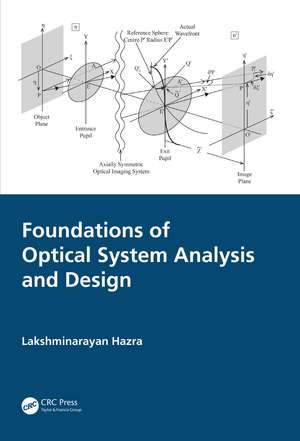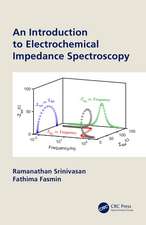Foundations of Optical System Analysis and Design
Autor Lakshminarayan Hazraen Limba Engleză Hardback – 7 feb 2022
With this backdrop in view, this book presents a holistic treatment of topics like paraxial analysis, aberration theory, Hamiltonian optics, ray-optical and wave-optical theories of image formation, Fourier optics, structural design, lens design optimization, global optimization etc. Proper stress is given on exposition of the foundations.
The proposed book is designed to provide adequate material for ‘self-learning’ the subject. For practitioners in related fields, this book is a handy reference.
Foundations of Optical System Analysis and Synthesis provides
- A holistic approach to lens system analysis and design with stress on foundations
- Basic knowledge of ray and wave optics for tackling problems of instrumental optics
- Proper explanation of approximations made at different stages
- Sufficient illustrations for facilitation of understanding
- Techniques for reducing the role of heuristics and empiricism in optical/lens design
- A sourcebook on chronological development of related topics across the globe
| Toate formatele și edițiile | Preț | Express |
|---|---|---|
| Paperback (1) | 463.30 lei 6-8 săpt. | |
| CRC Press – 4 oct 2024 | 463.30 lei 6-8 săpt. | |
| Hardback (1) | 1584.38 lei 6-8 săpt. | |
| CRC Press – 7 feb 2022 | 1584.38 lei 6-8 săpt. |
Preț: 1584.38 lei
Preț vechi: 1932.17 lei
-18% Nou
Puncte Express: 2377
Preț estimativ în valută:
303.21€ • 315.39$ • 250.32£
303.21€ • 315.39$ • 250.32£
Carte tipărită la comandă
Livrare economică 14-28 aprilie
Preluare comenzi: 021 569.72.76
Specificații
ISBN-13: 9781498744928
ISBN-10: 1498744923
Pagini: 774
Ilustrații: 275 Illustrations, black and white
Dimensiuni: 178 x 254 x 41 mm
Greutate: 1.59 kg
Ediția:1
Editura: CRC Press
Colecția CRC Press
ISBN-10: 1498744923
Pagini: 774
Ilustrații: 275 Illustrations, black and white
Dimensiuni: 178 x 254 x 41 mm
Greutate: 1.59 kg
Ediția:1
Editura: CRC Press
Colecția CRC Press
Notă biografică
Prof. Lakshminarayan Hazra obtained his M. Tech. and Ph.D. degrees from the University of Calcutta, and after several years in M/s National Instruments Limited, Calcutta and the Central Scientific Instruments Organisation (C.S.I.O.), Chandigarh, he joined the faculty of the Department of Applied Physics of the University of Calcutta in 1979.
Early in his career, he devised new techniques for imaging in telescopes working in turbulent medium, and in collaboration with Prof. H. H. Hopkins of University of Reading, U.K., he designed a remote access zoom objective for monitoring open-heart surgery in 1983. Prof. Hazra developed new methods for structural design of optical systems, as well as developed the optical design software ‘Ray Analysis Package’ (RAP). He pioneered the use of Walsh functions in image analysis and synthesis, and, in association with researchers at Laval University in Canada, investigated the exact surface relief profile of diffractive lenses in the non-paraxial region.
He took the lead in establishing the Department of Applied Optics and Photonics at the University of Calcutta in 2005. He is currently associated as an Emeritus Professor with this department. He is a Distinguished Fellow of the Optical Society of India (OSI) where he was General Secretary for more than 15 years, and currently he is the Editor-in-chief of the OSI ‘Journal of Optics’ published in collaboration with M/s Springer. He is a fellow of both the Optical Society of America and the SPIE. Prof. Hazra is the representative for the Indian Territory in the International Commission for Optics. He was conferred the ‘Eminent Teacher Award’ by the University of Calcutta in 2019.
Prof. Hazra has published more than 100 papers in archival journals, and a few research monographs. He has delivered more than 250 invited talks on his research in different parts of India and in many countries of the world, namely U.S.A., U.K., Canada, Japan, Austria, Poland, France, Germany, Netherlands, Italy, Slovenia, Malaysia, China, Finland, Russia etc. He provides consultancy services to industry on optical instrumentation, and regularly works for promotion of applied and modern optics. He was a Nuffield Foundation Fellow (1982-83) in U.K., a visiting Professor (1991 – 97) at the Centre d’Optique, Photonique et Lasers, Laval University in Quebec, Canada, an Erasmus Mundus Visiting Professor in the OpSciTech program of the European Commission in 2008, and a Visiting (Invitation) Professor of the Japan Society for Promotion of Science in 2012.
His areas of research interest are Optical System Design, Zoom Lens Design, Diffractive Optics, Optical and Ophthalmic Instrumentation, Aberration Theory, Theories of Image Formation, Super Resolution, Global Optimization, Laser Beam Shaping, Optical Tweezers, Fractal Optics, Metamaterials, Pareto-optimality and Solar Concentrator Optics. He has undertaken major research projects (funded by government agencies and private industries) on many of these topics. He has supervised the theses of more than twenty doctoral students, and more than a hundred Bachelor and Master level students in India and abroad.
Early in his career, he devised new techniques for imaging in telescopes working in turbulent medium, and in collaboration with Prof. H. H. Hopkins of University of Reading, U.K., he designed a remote access zoom objective for monitoring open-heart surgery in 1983. Prof. Hazra developed new methods for structural design of optical systems, as well as developed the optical design software ‘Ray Analysis Package’ (RAP). He pioneered the use of Walsh functions in image analysis and synthesis, and, in association with researchers at Laval University in Canada, investigated the exact surface relief profile of diffractive lenses in the non-paraxial region.
He took the lead in establishing the Department of Applied Optics and Photonics at the University of Calcutta in 2005. He is currently associated as an Emeritus Professor with this department. He is a Distinguished Fellow of the Optical Society of India (OSI) where he was General Secretary for more than 15 years, and currently he is the Editor-in-chief of the OSI ‘Journal of Optics’ published in collaboration with M/s Springer. He is a fellow of both the Optical Society of America and the SPIE. Prof. Hazra is the representative for the Indian Territory in the International Commission for Optics. He was conferred the ‘Eminent Teacher Award’ by the University of Calcutta in 2019.
Prof. Hazra has published more than 100 papers in archival journals, and a few research monographs. He has delivered more than 250 invited talks on his research in different parts of India and in many countries of the world, namely U.S.A., U.K., Canada, Japan, Austria, Poland, France, Germany, Netherlands, Italy, Slovenia, Malaysia, China, Finland, Russia etc. He provides consultancy services to industry on optical instrumentation, and regularly works for promotion of applied and modern optics. He was a Nuffield Foundation Fellow (1982-83) in U.K., a visiting Professor (1991 – 97) at the Centre d’Optique, Photonique et Lasers, Laval University in Quebec, Canada, an Erasmus Mundus Visiting Professor in the OpSciTech program of the European Commission in 2008, and a Visiting (Invitation) Professor of the Japan Society for Promotion of Science in 2012.
His areas of research interest are Optical System Design, Zoom Lens Design, Diffractive Optics, Optical and Ophthalmic Instrumentation, Aberration Theory, Theories of Image Formation, Super Resolution, Global Optimization, Laser Beam Shaping, Optical Tweezers, Fractal Optics, Metamaterials, Pareto-optimality and Solar Concentrator Optics. He has undertaken major research projects (funded by government agencies and private industries) on many of these topics. He has supervised the theses of more than twenty doctoral students, and more than a hundred Bachelor and Master level students in India and abroad.
Cuprins
1 Introduction.
2 From Maxwell’s Equations to Thin Lens Optics.
3 Paraxial Optics.
4 Paraxial Analysis of the Role of Stops.
5 Towards Facilitating Paraxial Treatment.
6 The Photometry and Radiometry of Optical systems.
7 Optical Imaging by Real Rays.
8 Monochromatic Aberrations.
9 Chromatic Aberrations.
10 Finite or Total Aberrations from System Data by Ray Tracing.
11 Hopkins’ Canonical Coordinates and Variables in Aberration Theory.
12 Primary Aberrations from System Data.
13 Higher Order Aberrations in Practice.
14 Thin Lens Aberrations.
15 Stop Shift, Pupil Aberrations and Conjugate Shift.
16 Role of Diffraction in Image Formation.
17 Diffraction Images by Aberrated Optical Systems.
18 System Theoretic Viewpoint in Optical Image Formation.
19 Basics of Lens Design.
20 Lens Design Optimization.
21 Towards Global Synthesis of Optical Systems.
Epilogue.
2 From Maxwell’s Equations to Thin Lens Optics.
3 Paraxial Optics.
4 Paraxial Analysis of the Role of Stops.
5 Towards Facilitating Paraxial Treatment.
6 The Photometry and Radiometry of Optical systems.
7 Optical Imaging by Real Rays.
8 Monochromatic Aberrations.
9 Chromatic Aberrations.
10 Finite or Total Aberrations from System Data by Ray Tracing.
11 Hopkins’ Canonical Coordinates and Variables in Aberration Theory.
12 Primary Aberrations from System Data.
13 Higher Order Aberrations in Practice.
14 Thin Lens Aberrations.
15 Stop Shift, Pupil Aberrations and Conjugate Shift.
16 Role of Diffraction in Image Formation.
17 Diffraction Images by Aberrated Optical Systems.
18 System Theoretic Viewpoint in Optical Image Formation.
19 Basics of Lens Design.
20 Lens Design Optimization.
21 Towards Global Synthesis of Optical Systems.
Epilogue.
Descriere
Analysis and design of optical/photonic systems call for applications of principles of optics of varying degrees of approximation at different stages. This book is designed to provide adequate material for ‘self-learning’ and also act as a handy reference for the students of related Masters and Doctoral courses.

















